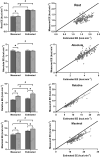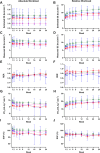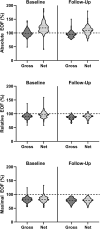Modulators of Energy Expenditure Accuracy in Adults with Overweight or Obesity: E-MECHANIC Secondary Analyses
- PMID: 39401314
- PMCID: PMC11801430
- DOI: 10.1249/MSS.0000000000003583
Modulators of Energy Expenditure Accuracy in Adults with Overweight or Obesity: E-MECHANIC Secondary Analyses
Abstract
Purpose: American College of Sports Medicine (ACSM) metabolic equations are used to estimate energy expenditure (EE) of physical activity and prescribe aerobic exercise to meet EE requirements. Limited evidence supports their accuracy in sedentary adults with overweight or obesity during controlled exercise interventions. The purpose of this study was to compare EE estimated by the ACSM walking equation versus EE measured by indirect calorimetry during a 24-wk aerobic exercise intervention, and identify potential modulators for their accuracy.
Methods: Data from the exercising groups (8 or 20 kcal·kg body weight -1 ·wk -1 ) of the E-MECHANIC study were utilized in this ancillary analysis ( N = 103). Every 2 wk for the initial 8 wk and monthly thereafter, EE was measured via indirect calorimetry during absolute (2 mph, 0% grade) and relative (65%-85% peak oxygen uptake (V̇O 2peak )) workload exercise. Resting metabolic rate, V̇O 2peak , and body composition were assessed at baseline and follow-up. An EE offset factor (EOF) was calculated to express measured EE as a percentage of the estimated EE at each workload (EOF < 100% represents an overestimation of ACSM estimated EE).
Results: The accuracy of the equation decreased with increasing exercise workload (0.44%, 9.2%, and 20.3% overestimation at absolute, relative, and maximal workloads, respectively, at baseline) and overestimation of EE was greater after the exercise intervention. Furthermore, race, sex, age, fat mass, and V̇O 2peak were identified as modulators for equation accuracy. Greater overestimation of EE was observed in Black compared with White females, particularly at lower exercise workloads.
Conclusions: These findings support future efforts to improve the accuracy of metabolic equations, especially in diverse populations. Researchers should account for exercise efficiency adaptations when using metabolic equations to prescribe exercise precisely.
Copyright © 2024 The Author(s). Published by Wolters Kluwer Health, Inc. on behalf of the American College of Sports Medicine.
Figures



Similar articles
-
CALCULATION OF TOTAL ENERGY EXPENDITURE IN ADULTS WITH CROHN'S DISEASE BY INDIRECT CALORIMETRY AND SIMPLE WEIGHT-BASED EQUATIONS: A COMPARATIVE STUDY.Arq Gastroenterol. 2025 Jun 16;62:e24122. doi: 10.1590/S0004-2803.24612024-122. eCollection 2025. Arq Gastroenterol. 2025. PMID: 40531684 Free PMC article.
-
Children and adolescents with overweight or obesity exhibit poor cardiorespiratory performance and elevated energy expenditure during an exercise task.PLoS One. 2025 Jul 8;20(7):e0327875. doi: 10.1371/journal.pone.0327875. eCollection 2025. PLoS One. 2025. PMID: 40627658 Free PMC article.
-
Physical activity, diet and other behavioural interventions for improving cognition and school achievement in children and adolescents with obesity or overweight.Cochrane Database Syst Rev. 2018 Mar 2;3(3):CD009728. doi: 10.1002/14651858.CD009728.pub4. Cochrane Database Syst Rev. 2018. PMID: 29499084 Free PMC article.
-
Physical activity, diet and other behavioural interventions for improving cognition and school achievement in children and adolescents with obesity or overweight.Cochrane Database Syst Rev. 2018 Jan 29;1(1):CD009728. doi: 10.1002/14651858.CD009728.pub3. Cochrane Database Syst Rev. 2018. Update in: Cochrane Database Syst Rev. 2018 Mar 02;3:CD009728. doi: 10.1002/14651858.CD009728.pub4. PMID: 29376563 Free PMC article. Updated.
-
Interventions for promoting habitual exercise in people living with and beyond cancer.Cochrane Database Syst Rev. 2018 Sep 19;9(9):CD010192. doi: 10.1002/14651858.CD010192.pub3. Cochrane Database Syst Rev. 2018. PMID: 30229557 Free PMC article.
References
-
- Swain DP, Franklin BA. Comparison of cardioprotective benefits of vigorous versus moderate intensity aerobic exercise. Am J Cardiol. 2006;97(1):141–7. - PubMed
Publication types
MeSH terms
Grants and funding
LinkOut - more resources
Full Text Sources
Medical

